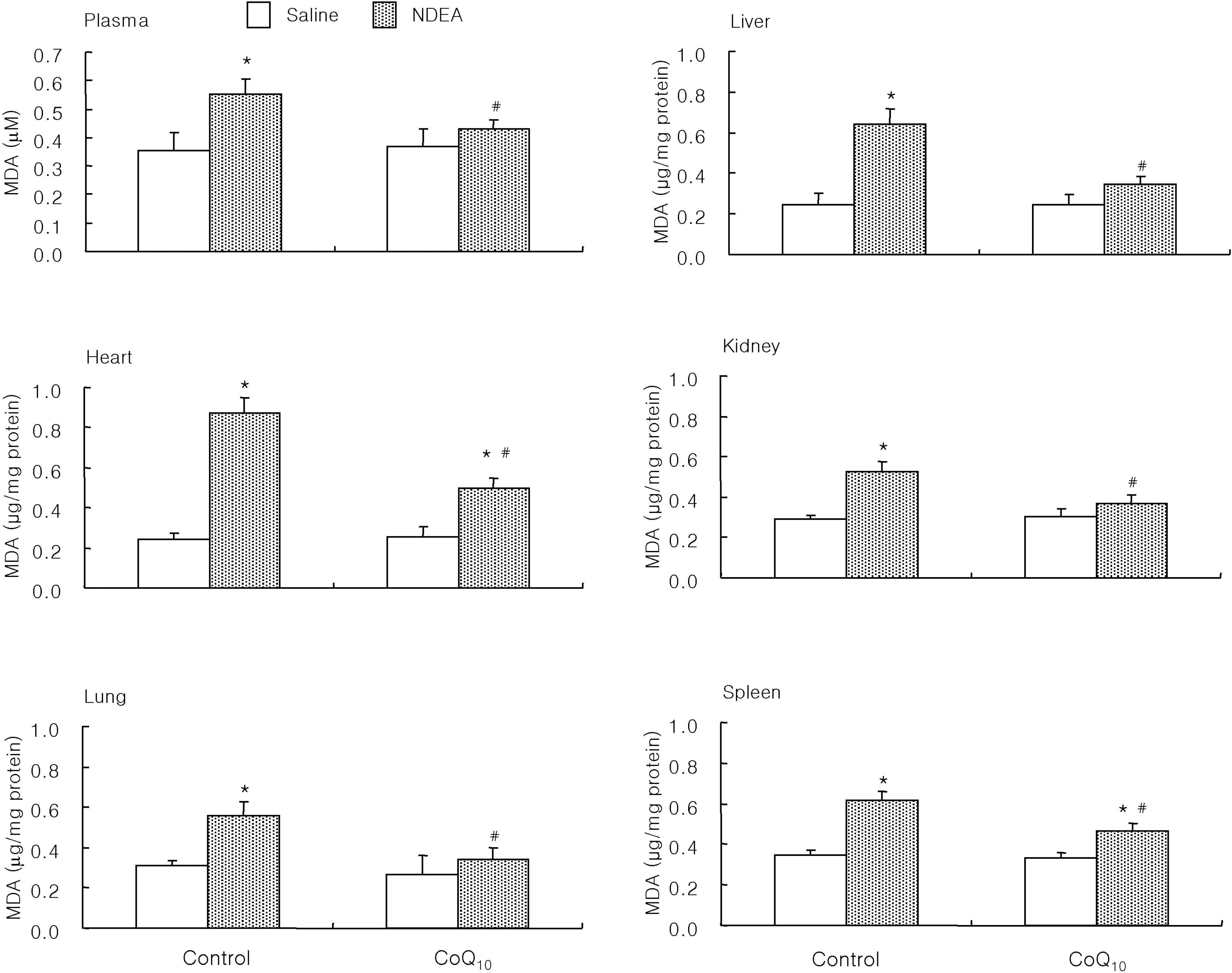Abstract
The antioxidant effect of CoQ10 on N-nitrosodiethylamine (NDEA)-induced oxidative stress was investigated in mice. Food intake and body weight were similar in both CoQ10 and control groups during the 3-week experimental period. NDEA significantly increased the activities of typical marker enzymes of liver function (AST, ALT and ALP) both in control and CoQ10 groups. However, the increase of plasma aminotransferase activity was significantly reduced in the CoQ10 group. Lipid peroxidation in various tissues, such as heart, lung, liver, kidney, spleen and plasma, was significantly increased by NDEA, but this increase was significantly reduced by 100 mg/kg of CoQ10. Superoxide dismutase activity increased significantly upon NDEA-induced oxidative stress in both the control and CoQ10 groups with the effect being less in the CoQ10 group. Catalase activity decreased significantly in both the control and CoQ10 groups treated with NDEA, again with the effect being less in the CoQ10 group. The lesser effect on superoxide dismutase and catalase in the NDEA-treated CoQ10 group is indicative of the protective effect CoQ10. Thus, CoQ10 can offer useful protection against NDEA-induced oxidative stress.
Go to : 
REFERENCES
Ames BN., Shigenga MK., Hagen TM. Oxidants, antioxidants and the degenerative diseases of aging. Proc Natl Acad Sci. 90:7915–7922. 1993.

Bansal AK., Bansal M., Soni G., Bhatnagar D. Modulation of NDEA induced oxidative stress by vitamin E in rat erythrocytes. Hum Exp Toxicol. 24:297–302. 2005.
Bansal AK., Bhatnagar D., Soni GL. In vitro effect of N-nitrosodi-methylamine on lipid peroxidation and antioxidant system in human erythrocytes. Toxicol In Vitro. 10:649–653. 1996.
Bartsch H., Hietanen E., Malaveille C. Carcinogenic nitrosamines: free radical aspects of their action. Free Radic Biol Med. 7:637–644. 1989.

Boland A., Delapierre D., Mossay D., Hans P., Dresse A. Propofol protects cultured brain cells from iron ion-induced death: comparison with trolox. Eur J Pharmacol. 404:21–27. 2000.

Ernster L., Dallner G. Biochemical, physiological and medical aspects of ubiquinone function. Biochim Biophys Acta. 1271:195–204. 1995.

King EJ., Delory GE. The rates of enzyme hydrolysis of phosphoric esters. Biochem J. 33:11–85. 1959.
Kirby AJ., Schmidt RJ. The antioxidant activity of Chinese herbs for eczema and of placebo herbs-I. J Ethnopharmacol. 56:103–108. 1997.
Kohen R., Nyska A. Oxidation of biological systems: oxidative stress phenomena, antioxidants, redox reactions and methods for their quantification. Toxicol Pathol. 30:620–650. 2002.
Marklund S., Marklund G. Involvement of the superoxide anion radical in the auto-oxidation of pyrogallol and a convenient assay for superoxide dismutase. Eur J Biochem. 47:469–474. 1974.
McCune LM., Johns T. Antioxidant activity in medicinal plants associated with the symptoms of diabetes mellitus used by the indigenous peoples of the north American boreal forest. J Ethnopharmacol. 82:197–205. 2002.

Noguchi N., Watanabe A., Shi H. Diverse functions of antioxidants. Free Radic Res. 33:809–817. 2000.

Nohl H., Gille L., Staniek K. The biochemical, pathophysiological, and medical aspects of ubiquinone function. Ann NY Acad Sci. 854:394–409. 1998.

Ohkawa H., Ohishi N., Yagi K. Assay for lipid peroxides in animal tissues by thiobarbituric reaction. Anal Biochem. 95:351–358. 1979.
Reitman S., Frenkel SA. Colorimetric method for the determination of serum glutamic oxaloacetic and glutamic pyruvate transaminases. Am J Pathol. 28:56–63. 1957.
Sawicka E., Dlugosz A. Toluene and P-xylene mixture exerts antagonistic effect on lipid peroxidation. in vitro. Int J Occup Med Environ Health. 21:201–209. 2008.

Sena CM., Nunes E., Gomes A., Santos MS., Proença T., Martins MI., Seiça RM. Supplementation of coenzyme Q10 and alpha-tocopherol lowers glycated hemoglobin level and lipid peroxidation in pancreas of diabetic rats. Nutr Res. 28:113–121. 2008.
Smith PK., Krohn RI., Hermanson GT., Mallia AK., Gartner FH., Provenzano MD., Fujimoto EK., Goeke NM., Olson BJ., Klenk DC. Measurement of protein using bicinchoninic acid. Anal Biochem. 163:279–282. 1987.

Spiteller G. Enzymic lipid peroxidation – a consequence of cell injury? Free Radic Biol Med. 21:1003–1009. 1996.
Sumioka I., Matsura T., Kasuga S., Itakura Y., Yamada K. Mechanisms of protection by S-allylmercaptocysteine against acetaminophen-induced liver injury in mice. Jpn J Pharmacol. 78:199–207. 1998.
Taniguchi M., Yasutake A., Takedomi K., Inoue K. Effects of N-nitrosodimethylamine (NDMA) on the oxidative status of rat liver. Arch Toxicol. 73:141–146. 1999.

Thomas WS. The physiology and pharmacology of singlet oxygen. Med Hypothesis. 60:567–572. 2003.
Woo CH., Eom YW., Yoo MH., You HJ., Han HJ., Song WK., Yoo YJ., Chun JS., Kim JH. Tumor necrosis factor-alpha generates reactive oxygen species via a cytosolic phospholipase A2-linked cascade. J Biol Chem. 275:32357–32362. 2000.
Go to : 
 | Fig. 1.The effect of CoQ10 on NDEA-induced lipid peroxidation in murine tissues. Malondialdehyde (MDA) is an index of lipid peroxidation in oxidative stress induced by 200 mg/kg NDEA. CoQ10 in olive oil (100 mg/kg) was orally administered to the CoQ10 group for 3 weeks, while an equal volume of olive oil was orally administered to the control group. Results are means±SD from 8 mice. ∗significantly different from saline group (p<0.05), #significantly different from NDEA control group (p<0.05). |
 | Fig. 2.The effect of CoQ10 on superoxide dismutase (SOD) activity in murine tissues treated with 200 mg/kg NDEA. CoQ10 in olive oil (100 mg/kg) was orally administered to the CoQ10 group for 3 weeks, while an equal volume of olive oil was orally administered to the control group. Results are means±SD from 8 mice. ∗significantly different from saline group (p<0.05), #significantly different from NDEA control group (p<0.05). |
 | Fig. 3.The effect of CoQ10 on catalase activity in murine tissues treated with 200 mg/kg NDEA. CoQ10 in olive oil (100 mg/kg) was orally administered to the CoQ10 group for 3 weeks, while an equal volume of olive oil was orally administered to the control group. Results are means±SD from 8 mice. ∗significantly different from each saline group (p<0.05), #significantly different from NDEA group of control (p<0.05). |
 | Fig. 4.The effect of CoQ10 on intracellular reactive oxygen species (ROS) production induced by 1 mg/ml silica in RAW 264.7 cells. Results are means±SD from 4 separate experiments. |




 PDF
PDF ePub
ePub Citation
Citation Print
Print


 XML Download
XML Download